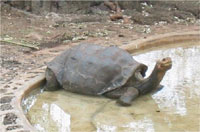World’s only giant tortoise from Galapagos Islands to become father
Lonesome George, the long-living Galapagos Islands giant tortoise thought to be the last of his kind, might soon be a father.

The Galapagos National Park announced Monday that a female tortoise that has accompanied George since 1993 laid three intact eggs that are being cared for in an artificial incubator.
The eggs have appeared "after 36 years of multiple efforts ... when we thought it was impossible for the tortoise known as Lonesome George to reproduce," the park said in a statement.
The female belongs to the closest existing phenotype to that of George. Found in 1972 on Pinta island, George is estimated to be in his 70s - middle age for a giant tortoise.
It will take another 120 days to learn if the eggs are viable.
The Galápagos tortoise (or Galápagos giant tortoise), is the largest living tortoise, endemic to nine islands of the Galápagos archipelago. Adults of large subspecies can weigh over 300 kilograms (660 lb) and measure 1.2 meters (4 ft) long. Life expectancy of a wild tortoise is estimated to be 150-200 years.
The Galápagos tortoise is found on the Galápagos Islands west of Ecuador in South America. The shape of the carapace of some subspecies of the tortoises reminded the Spanish explorers of a kind of saddle they called a "galápago," and for these saddle-shaped tortoises they named the archipelago. As many as 250,000 tortoises inhabited the islands when they were discovered. Today only about 15,000 are left (according to estimates by the Charles Darwin Foundation and Galapagos National Park Service), mainly due to harvest by whalers and pirates that killed them for food during the 18th and 19th centuries. Turned on their backs so they could not move, the Galápagos tortoise could survive for months without food or water, making them a good source of fresh meat on a whaling ship (before refrigeration). Their diluted urine could also be used as drinking water. In addition, non-native species such as goats were introduced on some islands resulting in destruction of the vegetation that provides the tortoises' diet; the resulting habitat loss further diminished the tortoise population.
Subscribe to Pravda.Ru Telegram channel, Facebook, RSS!


